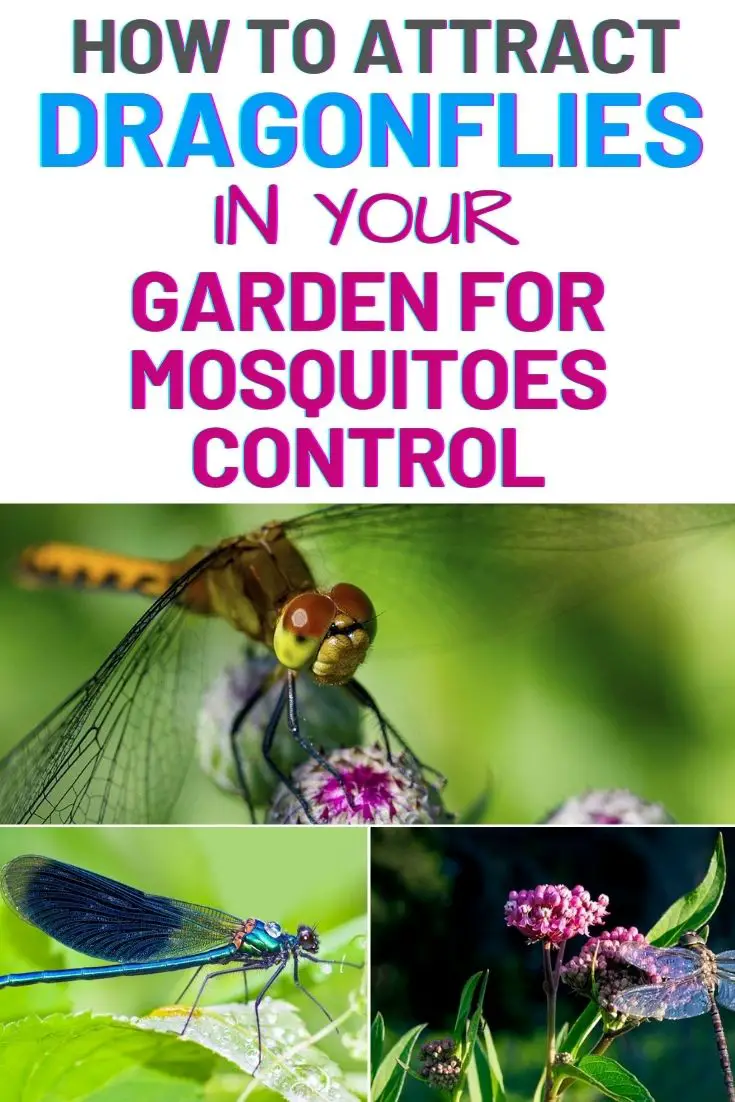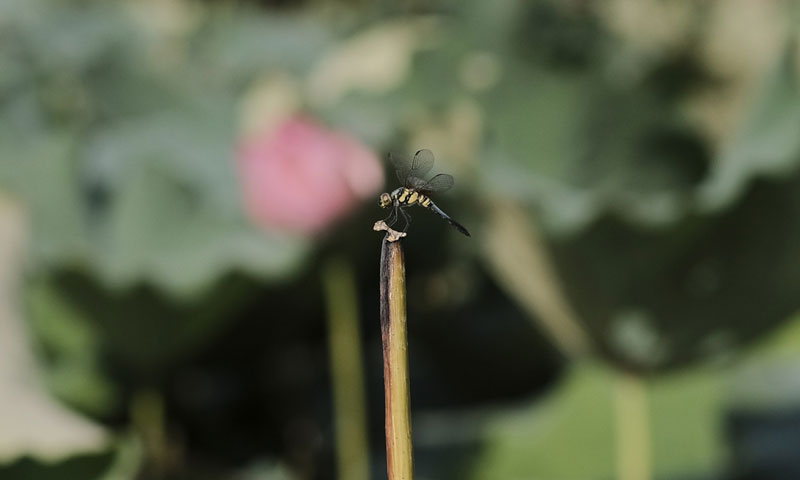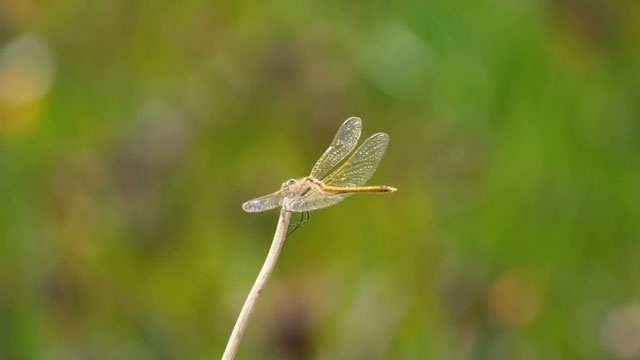Wondered what it would be like to watch a dragonfly flit and hover around your garden? The beauty of their flight and coloration makes them a sight to behold. I, as a professional in the field of garden wildlife, think it’s important for everyone to have the opportunity to appreciate these amazing creatures up close.
Dragonflies are pure carnivores, and their staple food is through eating small bugs. A dragonfly can eat a lot. A single dragonfly, every half an hour will eat food equal to its body weight. Since they are pure carnivores, they won’t damage plants and flowers.
Therefore, you should attract them to come over as they are beneficial insects since you can have them as the natural pest control for your garden.
The other cool thing about dragonflies is they only hang out in areas that have clean air. Generally, a swampy area has clean air, and that’s the ideal place for dragonflies to inhabit.
If we want to attract dragonflies to our garden, there is something that we can do.
1. Creating A Suitable Habitat
If you want dragonflies to visit your garden, you must provide a habitat for them. As a result, you should provide plenty of ponds and streams so that they can do their business in peace.
Dragonflies also need areas with ample vegetation growth around the water sources in order to feed on insects and find shelter from birds. You need to ensure that these habitats offer enough protection from direct sunlight; otherwise, the larvae will not have adequate places to hide away during the daytime.
2. Plant Selection
Now that you have a place that dragonflies can call home, you can start thinking about what plants you can put there to entice them. Choosing the right plants is a crucial part of making their habitat thrive. Choosing which plants to incorporate is no easy task for a number of reasons.
You can look for flowers and foliage with bright colors like yellow or pink. Dragonflies love nectar-producing blooms such as lilies, zinnias, coreopsis, and cosmos. They also prefer tall grasses and reedy vegetation because they provide shelter from predators while allowing plenty of room for flying around.
If possible, try planting some aquatic vegetation near your pond as dragonflies lay their eggs on water plants like cattails and bulrushes. Furthermore, adding flowering shrubs and trees along the edge of your garden will give dragonflies more places to perch during flight breaks.
Making sure there is enough open space between plantings is key since dragonflies need ample area in order to fly around freely without obstruction. By selecting the right flora for your yard, you can create an inviting atmosphere that attracts beautiful dragonflies throughout the season.
3. Pond and Water Quality Requirements
Creating the perfect habitat for dragonflies starts with providing a clean water source. Dragonfly larvae, or nymphs, are aquatic predators and require specific water conditions to thrive. In fact, it’s estimated that about 95% of all dragonflies depend on standing freshwater during their lifecycle!
To ensure your pool is suitable for these delicate creatures, make sure you take the following steps into consideration:
- Test the pH – Aim for levels between 6.5-7.2.
- Check oxygen levels – Dragonfly larvae need dissolved oxygen levels of at least 4 ppm.
- Avoid pollutants – Nutrient pollution can cause algal blooms which affects water quality.
In addition to these requirements, adding some aquatic plants as well as rocks and debris will create hiding places and hideouts for adults and juveniles alike. Taking care in creating this safe environment is essential to attracting a thriving population of dragonflies to your garden.
4. Providing A Food Source
Now that the water is fit for dragonflies, you should provide them with a food source. As predators, dragonflies feast on other insects in the air, including mosquitoes, gnats, flies, and other flying bugs. They won’t visit unless you make your garden suitable for their preferred prey species.
Planting native plants can help as they often host insect populations which in turn will bring in their predator – the dragonfly! A good way to supplement this is by providing a shallow container with some dead leaves or bark chips. This provides a habitat where larvae can grow and develop before emerging into adults.
5. Lighting Conditions
Dragonflies are attracted to a garden that has plenty of sunlight, so it’s important to ensure your outdoor space is well-lit. As long as you can provide at least eight hours of direct light each day, dragonflies should be able to find their way into your yard. You may also want to consider installing solar-powered lights in the evenings for extra illumination. This could attract even more insects and help increase the local dragonfly population.
When selecting lighting for your garden, avoid any bright white or blue lights; these colors do not usually appeal to dragonflies or other beneficial bugs. Instead, opt for warm yellow tones which will look great while still being attractive to wildlife visitors. It’s also important to note that LED bulbs tend to use less energy than traditional incandescent bulbs and they last longer too.
6. Insecticides To Avoid
As dusk envelops the garden and dragonflies start to flutter around, it’s essential to consider what insecticides should be avoided. While many lawn care products can help keep pests away, they also have a nasty habit of driving beneficial insects like dragonflies away. To ensure your garden remains attractive to these majestic creatures, here are some of the most common insecticides you’ll want to avoid.
You should always stay clear of any harsh chemical-based sprays or powders that contain harmful toxins such as carbaryl, malathion, and diazinon. These ingredients can kill not only the pests but also other organisms in the garden environment – including our beloved dragonflies! Instead, opt for natural alternatives like nematodes or biological controls which are both effective and safe for all wildlife.
Also, steer clear of baits containing metaldehyde or bromethalin since these chemicals remain active even after application and could harm dragons if ingested accidentally. If you must use them, make sure to follow safety instructions carefully and never leave bait out overnight where birds or animals may mistakenly consume it.
You must resist using aerosols or foggers as these tend to linger in the air rather than settle on surfaces. As a result, any dragonfly flying through an area treated with one of these toxic substances is likely to inhale its contents – leading to potentially disastrous consequences! With this in mind, pay attention whenever spraying liquids near flowerbeds or areas where dragonflies rest; instead take precautionary measures by wearing protective gear when dealing with dangerous pesticides.
7. Add A Variety Of Rocks
Rocks can add a stunning element to any garden. Dragonflies love them! They use the sun’s light reflecting off the rocks for warmth, so they’ll often be seen perched on top of them in hot weather.
Adding different sizes and shapes of rocks also creates small crevices that dragonflies will enjoy exploring. Plus, it provides extra protection from predators such as birds or spiders. It’s easy to create an inviting habitat for these beautiful creatures with just a few strategically placed stones.
For maximum benefit, choose flat rocks that are free of cracks and breaks. This allows sunlight to easily penetrate the surface which helps keep dragonflies warm during colder months. Additionally, using colored stones like blue-gray slate is particularly attractive as this color tends to draw both heat and wildlife into your garden!
8. Decide Your Natural Pest Control
Once you have created the perfect environment for your dragonflies with a variety of rocks, it’s time to decide on natural pest control methods. Believe it or not, dragonflies can be an effective way to reduce pests in your garden! They are voracious hunters that feed on small insects like mosquitoes and other biting bugs. Plus, they look absolutely stunning as they flit around your backyard oasis.
However, there is more to consider when choosing natural ways to keep unwanted critters away from your garden than just adding dragonflies. You may also want to plant specific flowers and herbs known for deterring certain pests – lavender and chrysanthemums are two examples that help ward off mosquitos. Additionally, some plants naturally attract beneficial predators such as spiders which hunt down nuisance bugs like aphids and thrips. It’s amazing how quickly nature works its magic once you’ve set up the proper conditions!
Finding a balance between predator-prey relationships is key to keeping your garden thriving without resorting to harsh chemical pesticides. With some careful planning and research into local wildlife habits, you too can create a beautiful sanctuary for dragonflies while ensuring all of your hard work doesn’t go to waste due to pesky intruders. Get ready to witness firsthand Mother Nature’s fascinating circle of life right before your eyes!
What colors of plants attract dragonflies?
There is no specific color that dragonflies incline to. Thus the color of the plants is not a major factor for you to attract dragonflies to visit your garden. What you can grow are tall plants and bushes where dragonflies like to live in.
What plants are dragonflies attracted to?
Have a pond alone if your garden won’t attract dragonflies. It would help if you had aquatic plants in the pond. Dragonflies love tall plants and also aquatic plants. Dragonflies will lay eggs on aquatic plants, and the larva will grow on those plants. Once they grow up, they will inhabit tall plants.
You can put submerged and floating plants in the pond. Dragonflies love plants like eelgrass, passionflower, snapdragon, pineapple, wild celery, corkscrew, blue flag iris, parrot feather, seaweed, water lily, and lotus.
For example, you can grow lobelia, seedboxes, or button shrubs in your garden. You can also let the natural grass and bushes grow around the pond so that the dragonflies have more vegetation.
Certain flowers will help attract dragonflies to your garden. You can plant them near water sources, in flower beds, or in your garden to attract dragonflies to visit.
Ideal plants include black-eyed Susan flowers, blanket flowers, cardinal flowers, Asteraceae, bee balm, catnip, coneflowers, golden Alexandria, phlox, Russian sage, salvia, or arrow grass.
Do dragonflies really help to keep mosquitoes away?
Dragonflies are carnivorous, and they eat a lot of small insects. In addition to eating more than 100 mosquitoes every day, some adult dragonflies also eat many other small insects.
If you provide them with the right living conditions, dragonflies will make your garden their home, and mosquitoes will be their dinner.
How do you attract dragonflies to eat mosquitoes?
A pond and fountain are ideal water features to attract dragonflies to come to your garden. If you have mosquito issues with your garden, you may consider building a pond or a fountain there to attract dragonflies to breed and help you get rid of mosquitoes.
You don’t need to build a huge and peculiar water feature. A pond with a shallow area with a height of about 60 cm is good enough. Adult male dragonflies tend to build their territories along the edges of ponds.
Dragonflies love sunny and warm weather. The weather condition that they like is the temperature that is over 65°C. They will hide in vegetation if the environment is too wet or cold.
Another way to attract dragonflies to eat mosquitoes is by building some poles for them. If you do not yet know, dragonflies actually love to stop on sticks. So if you want to have more dragonflies, you may try to get some bamboo sticks and place them around your garden to make poles for them.
The bamboo sticks let the dragonflies perch on them. If you place many bamboo sticks in different areas of your garden, you will see almost every stick with a dragonfly stop on them. It helps them to target and hunt their prey as well.
How to attract dragonflies to your yard if you don’t have a pond?
What draws dragonflies to your yard is a pond with shrubs and flowers. If you don’t have a pond in your yard, there are still some other ways to think about it.
Stagnant water
Dragonflies are attracted to places with standing water, such as ponds, streams, and wetlands. They often appear on moist grass with many flowers.
If there are ponds or creeks near your land, or the recent rainfall has made your yard wet, this may attract dragonflies to your yard. Dragonflies tend to reproduce in water and feed on insects near the water, such as mosquitoes.
Weather
If you suddenly found a flock of dragonflies in your garden, this may be due to weather conditions that have to create an ideal environment for insects to thrive.
For example, the summer of 2010 was a record year for dragonflies in Wisconsin and elsewhere because the early deep snow combined before the wetlands froze in the previous winter. An early warm spring provided abundant food for insects; hot and humid summers created perfect breeding conditions for dragonflies.
You can also set up an inflatable pool for dragonflies to breed. Another idea is to get a wooden barrel and fill the water in there. Then place the wooden barrel in your garden, and add plants and shrubs around the wooden barrel.
By attracting them to your yard, you can get the benefits of keeping mosquitoes and some other unwanted insects away. It would be best if you didn’t worry about dragonflies will damage your garden.
They are actually beneficial insects, and they don’t bother you at all. They are friendly bugs that you can get to reduce the pest insects, including mosquitoes, and help control the pest population.
Therefore, you should be more than happy when you start seeing dragonflies flying around your garden.
You can watch this video on how a dragonfly catches and eats a mosquito. It’s just amazing!
Did you find this post useful? Would you like to get back to it later? Save THIS PIN below to your gardening and pest control boards on Pinterest! Thanks 🙂




